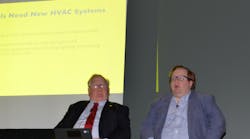by George Benda
Mold is increasingly emerging as a significant threat to contractors across the country.
First, there’s the inherent liability that automatically comes from working in this industry. As soon as you’ve installed an HVAC system, you’ve created an environment where mold will grow if the system hasn’t been installed properly.
Second, there’s the insurance issue. Because of this inherent liability and the multitude of high-profile lawsuits and large payouts, many insurance companies have not only increased premiums, but have refused to cover mold-related incidents.
Despite this negative picture, there is hope. The key is to manage the risk mold presents.
Stop it Before it Starts
Unlike asbestos or lead, eliminating the physical signs of mold doesn’t mean it’s gone. If you don’t address the cause, you will have to remediate over and over. Therefore, the best way to manage the risk of mold is to understand how and why it develops and to prevent it.
For example, in new construction projects, you must ensure that you’re not building over, or building in, problems. This means not installing equipment that was shipped wet or sat in the yard and grew mold. Any equipment subject to these conditions must be decomtaminated or there will definitely be problems along the way.
On the service side, it’s critical to be aware of all the factors that contribute to elevated levels of moisture in buildings. For example, I’ve seen many instances where drain pans holding water have been ignored. Keeping an eye on something as simple as this can do wonders to prevent mold development.
It’s also critical to pay attention to how the system is operating. With variable air volume (VAV) systems, the face velocity across the coil shouldn’t exceed 550 fpm. At excessive speeds, water won’t drip across the coil and down to drain pan. Instead, it will be blown right into the ductwork, causing the downstream portion of the air handler, then the ductwork to become contaminated.
Even measures intended for energy efficiency can lead to trouble. In humid climates, chilled water coil reset programs, cycling of equipment, and night setback can do more harm than good if you don’t take into account that when the unit goes off, it isn’t supplying outside air. If the exhaust is running 24 hr/day and the building has been put under negative pressure, the entire building envelope will be compromised.
Because of the myriad of contributing factors to HVAC-related mold growth, education is essential. There are a number of excellent mold-related training and certification programs to help contractors and their employees keep mold and liability claims under control.
The Truth Might Set You Free
With their rates increasing and coverage diminishing, many contractors feel that insurance coverage for mold claims are something of the past.
However, what they don’t realize is that there is hope, particularly if they’re doing things right.
For example, I know a contractor who received an unpleasant call from his insurance company, informing him that anything related to mold wasn’t going to be covered. When he asked how much it was going to cost to keep that same insurance, he was informed his rates would increase five-fold.
Because this contractor had a terrific track record, he decided he shouldn’t be punished for the sins of others. Therefore, he put together a proposal indicating the high level of training offered to employees (especially indoor air quality-related), proof of certifications, quality control procedures in place, and proof that his company was a good corporate citizen with no claims or lawsuits against it. As a result, not only did he keep his coverage, his insurance rates were reduced.
Therefore, if your record can speak for itself, it’s worth the effort to work with your current insurance carrier or approach another firm to see if you can keep your coverage or purchase a specialty policy. You’ll be glad you did. n
George Benda is senior principal, chairman, and CEO of the Chelsea Group. He is also a member of Contracting Business’ editorial advisory board. Chelsea Group offers a program in mold risk management. For more information, call 800/626-6722.










